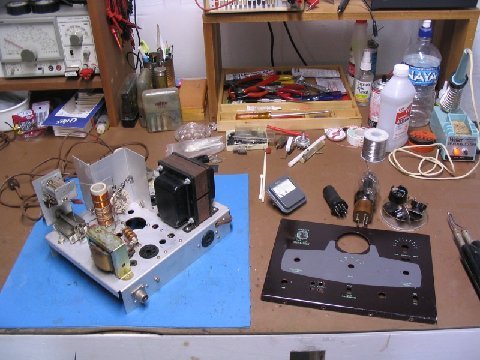Stepping Back in Time
OK, a lot of you - especially old timers - know the drill. You decide to travel back to an earlier time when ham radio was both more fun and more of a challenge, with fewer bells & whistles and more annoyances. So, you buy a "vintage" rig - meaning something made before 1980 or so, with lots of vacuum tubes in it. Maybe you go for the kind of equipment you started with, or perhaps you just settle for something from that general era, maybe a rig you never owned but always wondered about.
You buy it on eBay - perhaps paying too much for what you get - or from an advertisement on eHam Classifieds or ARRL Classifieds or QTH.com classifieds, or whatever. Then the fun starts.
This is the fourth or fifth time I've been down this road and every time I swear it will be the last. Maybe this time it will be. At any rate, here's a photo of Version 1 of the latest K4MSG vintage station which has been on the air about a month and has accounted for 8 countries during casual operating.
The Drake R-4A was purchased from K6CVC and worked OK from the get-go. After re-capping, changing a couple of tubes and an alignment it works even better. This receiver is absolutely pristine, the nearest to new-looking I've ever seen.

TOP ROW, L to R: Johnson Viking 122 VFO, Drake MS-4 speaker, Johnson Viking Adventurer CW transmitter.
BOTTOM ROW, L to R: Drake R-4A receiver, WWII J-38 key, WWII Lionel J-36 bug. FOREGROUND: Telephonics TDH-39 headset. The metal box mounted on the right below the headphone jack is the manual T/R switch. The patch panel on the left is for my tape-cassette-phonogragh-to-CD setup for copying old tapes & records to CD.
The Viking Adventurer was purchased on eBay and is almost 100% original (it does have the internal fuseholder replaced with one on the rear apron, an improvement IMO) and very, very clean. It had already been re-capped, required no rehab and runs fine with a maximum output of about 38 watts. It has a nice front panel and the cabinet was professionally repainted.
The Viking 122 VFO is OK. On 80m it works great and is very stable (using the 160/80/40 setting) but on 40m (using the 40/20/15/10 setting) it is less stable and has a tendency to "pull" when the transmitter is keyed, requiring some "tweaking" of the transmitter oscillator tuning to vary the load on the VFO. Unfortunately, the 40m harmonic on the 160/80/40 setting doesn't provide sufficient grid drive to the Adventurer and the maximum output is only about 15 watts so the 40/20/15/10 setting must be used. More work is needed to resolve the stability problem which may be partially a mechanical issue.
